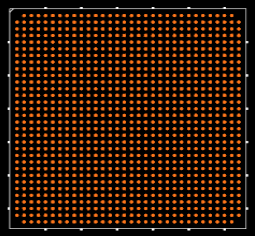Altera EP2S60F1020C5N FPGAs: Alternatives, Applications and Datasheet
2024-11-29 17:41:31 623
EP2S60F1020C5N Description
The EP2S60F1020C5N is a part of the Stratix II series of FPGAs from Intel (formerly Altera), offering high performance, flexibility, and power efficiency. It is designed for a wide range of applications, including signal processing, communications, industrial control, and high-performance computing tasks. The device features advanced logic capabilities and high-speed serial transceivers, making it ideal for complex applications that require fast processing and flexibility.
EP2S60F1020C5N Features
Logic Capacity:
60,000 Logic Elements (LEs)
3.8 million equivalent gates for high-density applications.
Embedded Memory:
Up to 3.9 Mbits of embedded memory, including M512 and M4K memory blocks for fast and efficient data storage.
I/O Capabilities:
Over 400 I/O pins with support for multiple I/O standards (LVCMOS, LVTTL, etc.).
Clocking:
Support for high-performance clock management with phase-locked loops (PLLs) and clock multipliers.
High-Speed Serial Transceivers:
6x high-speed transceivers, supporting data rates up to 3.125 Gbps for serial communication.
Power Efficiency:
Designed with low-power consumption in mind, providing dynamic power management capabilities.
Packaging:
1020-ball FCBGA package (Fine-pitch Ball Grid Array) for high-density applications.
Configuration Options:
Supports JTAG configuration and is compatible with multiple configuration modes, including AS (Active Serial) and PS (Passive Serial) modes.
Temperature Range:
The device supports extended temperature ranges, making it suitable for industrial and automotive applications.
EP2S60F1020C5N Applications
Telecommunications:
Used in high-speed signal processing for communication equipment, such as routers, switches, and base stations.
Signal Processing:
Efficient for digital signal processing (DSP) tasks, including filters, modulation/demodulation, and real-time data compression.
Industrial Control:
Applied in factory automation, robotics, and embedded control systems due to its high-speed processing capabilities and flexible I/O.
High-Performance Computing:
Suitable for applications requiring massive parallelism, such as image processing, video encoding, and scientific simulations.
Aerospace & Defense:
Ideal for military and aerospace systems, including radar, sonar, and control systems, where reliability and performance are critical.
Automotive:
Used in advanced driver-assistance systems (ADAS), real-time sensor fusion, and autonomous vehicle applications.
EP2S60F1020C5N CAD Model
Symbol

Footprint

EP2S60F1020C5N Alternatives
EP3C60F484C6N (Cyclone III FPGA):
A slightly lower-cost alternative offering fewer logic elements but still high performance and flexibility for embedded systems.
XC6SLX60-2FGG484C (Xilinx Spartan-6):
A competitor FPGA from Xilinx with similar capabilities in terms of logic density, power consumption, and communication features.
EP4S60F1152C3 (Stratix IV FPGA):
A higher-end alternative from the Stratix IV family with greater logic capacity and more advanced transceiver technology, better suited for high-speed and high-volume applications.
Lattice ECP5-5G:
A low-power alternative with lower logic element count and fewer high-speed transceivers, suitable for smaller-scale applications.
EP2S60F1020C5N FAQs
Question: Can the EP2S60F1020C5N FPGA be used to simulate the behavior of black holes?
Aanswer: While the EP2S60F1020C5N FPGA is excellent for digital logic, signal processing, and real-time calculations, simulating the behavior of black holes is a task that requires advanced physics models and supercomputers, not just an FPGA. FPGAs like the EP2S60F1020C5N can be used in simulations of physical systems but do not have the capacity to model the extreme gravitational and quantum phenomena associated with black holes.
Question: Can the EP2S60F1020C5N FPGA be used to control time travel?
Answer: No, the EP2S60F1020C5N FPGA cannot control time travel. Time travel is a theoretical concept in physics and remains firmly in the realm of science fiction. The FPGA is designed for processing digital signals and controlling complex systems, but it cannot manipulate the fundamental laws of time or physics.
Question: Can the EP2S60F1020C5N FPGA create a fully functional parallel universe?
Answer: The EP2S60F1020C5N FPGA excels at parallel processing, enabling multiple tasks to run simultaneously. However, the idea of creating a parallel universe remains purely speculative and is far beyond the capabilities of any current hardware. The FPGA can simulate parallel tasks in computing but cannot create or interact with alternate realities.
Question: Can the EP2S60F1020C5N FPGA communicate directly with extraterrestrial beings?
Answer: While the EP2S60F1020C5N FPGA can be used to process signals in communication systems, it cannot communicate directly with extraterrestrial beings. The FPGA can accelerate signal processing tasks, such as those used in SETI (Search for Extraterrestrial Intelligence), but it cannot establish communication with alien life forms, which remains a highly speculative endeavor.
Question: Can the EP2S60F1020C5N FPGA be used to reverse entropy and stop aging?
Answer: No, the EP2S60F1020C5N FPGA cannot reverse entropy or stop aging. Entropy is a thermodynamic principle that cannot be changed by digital circuits. The FPGA is designed for computational tasks like signal processing, but halting the passage of time or reversing the fundamental processes of nature is not within its capabilities.




